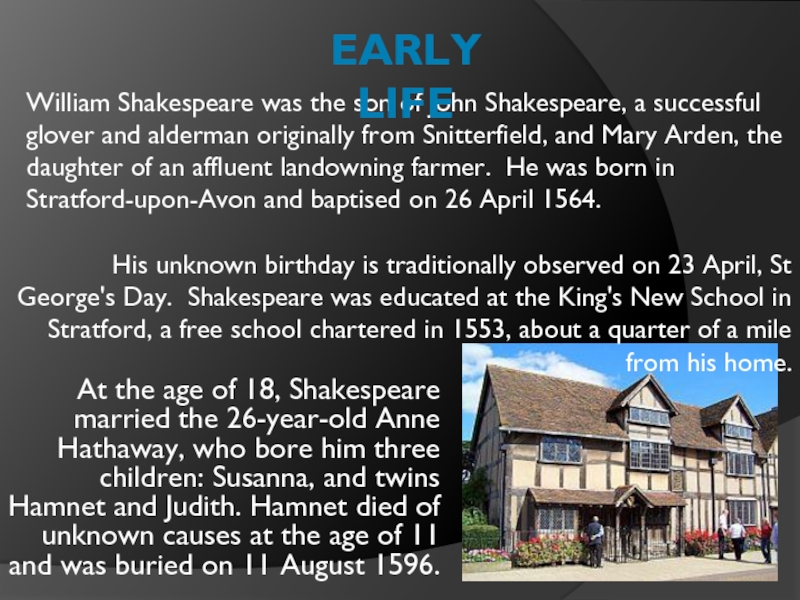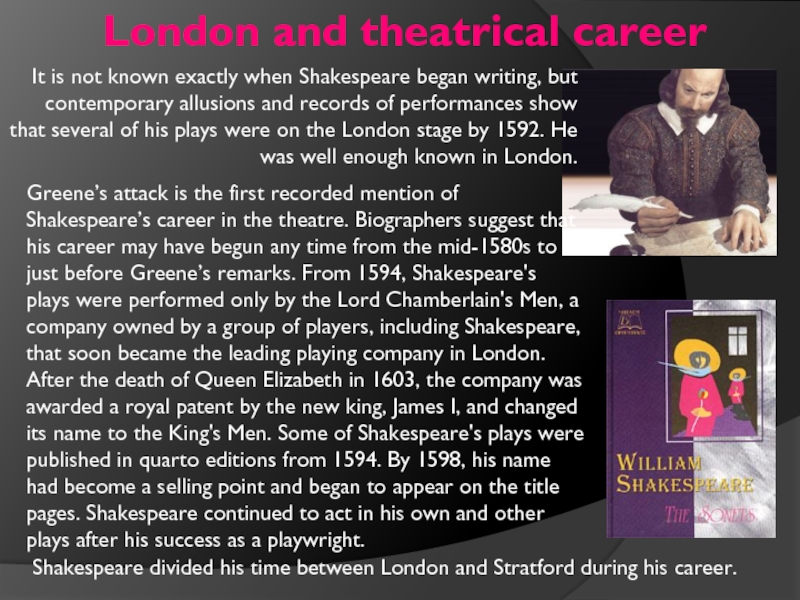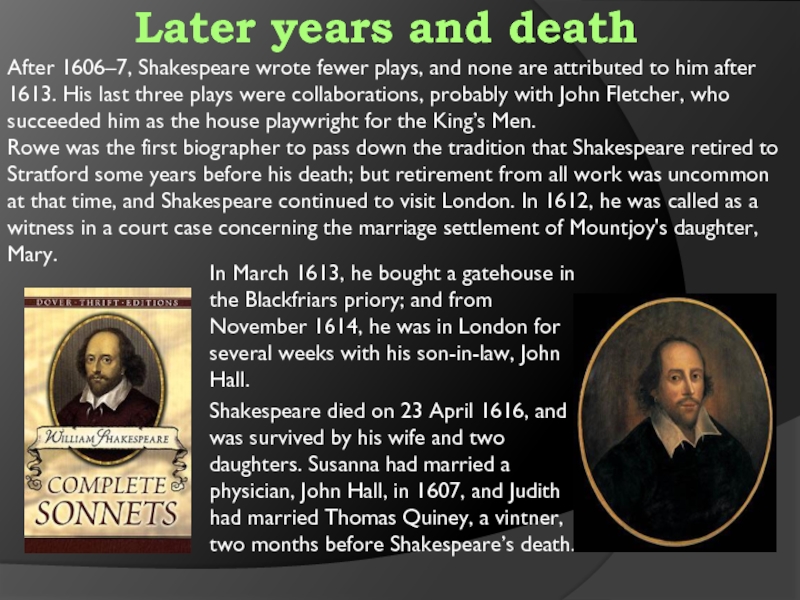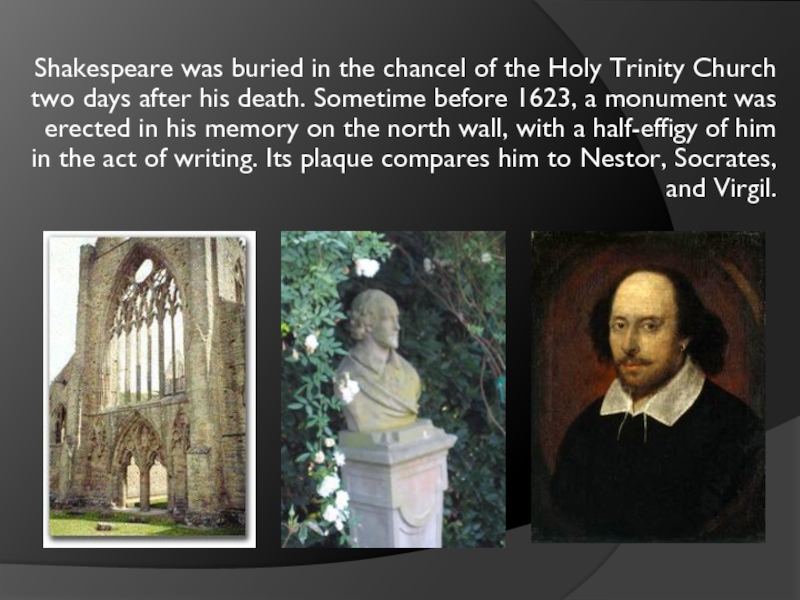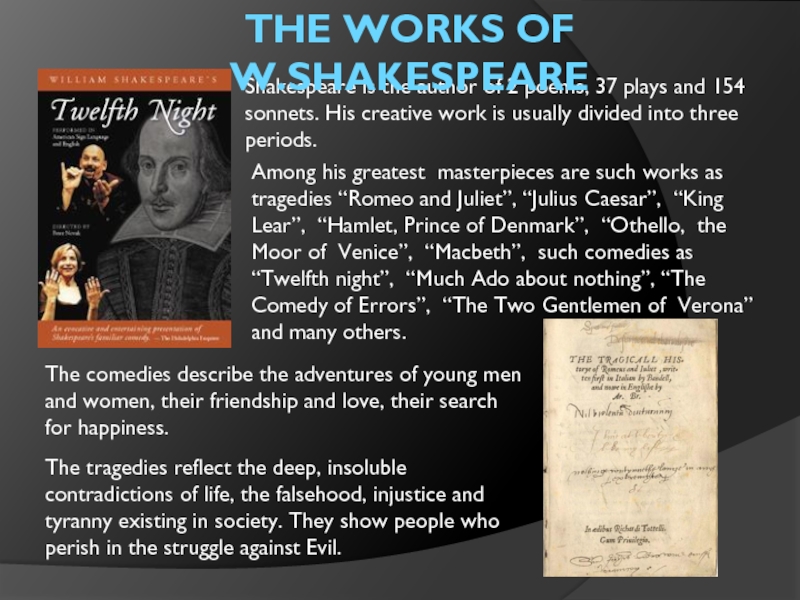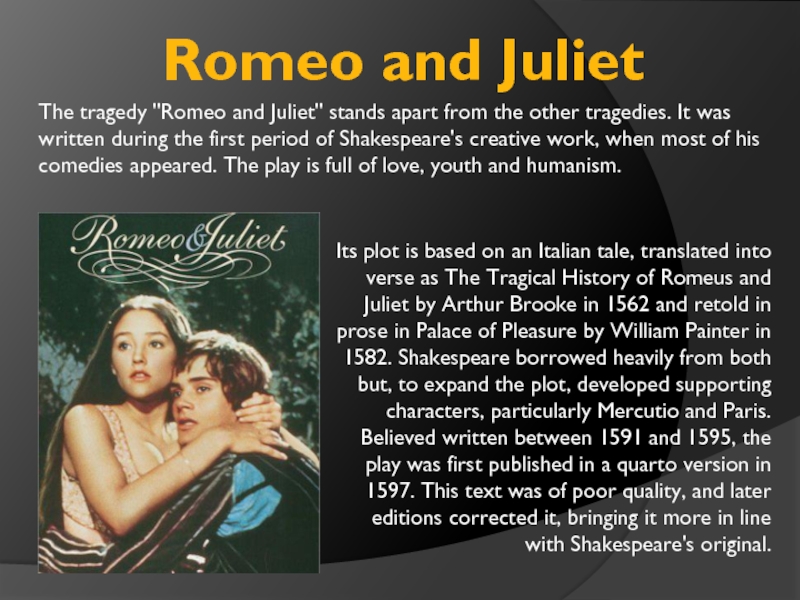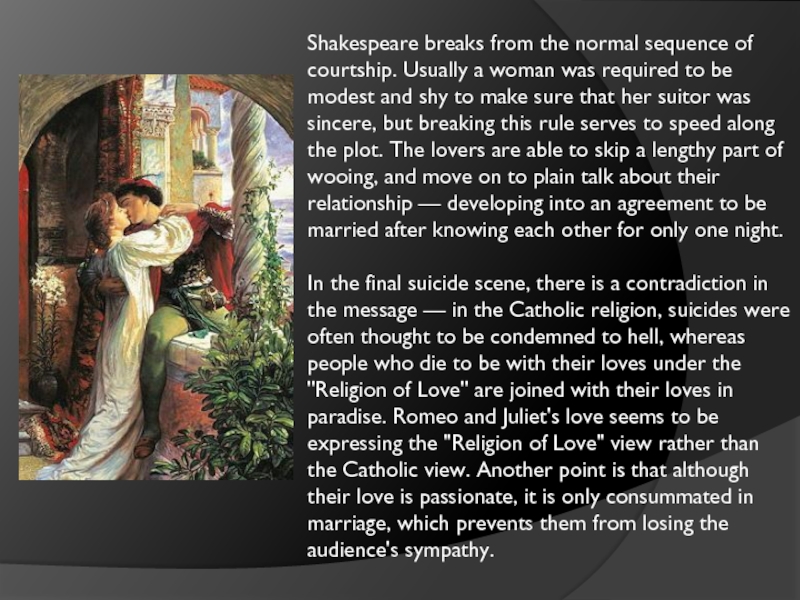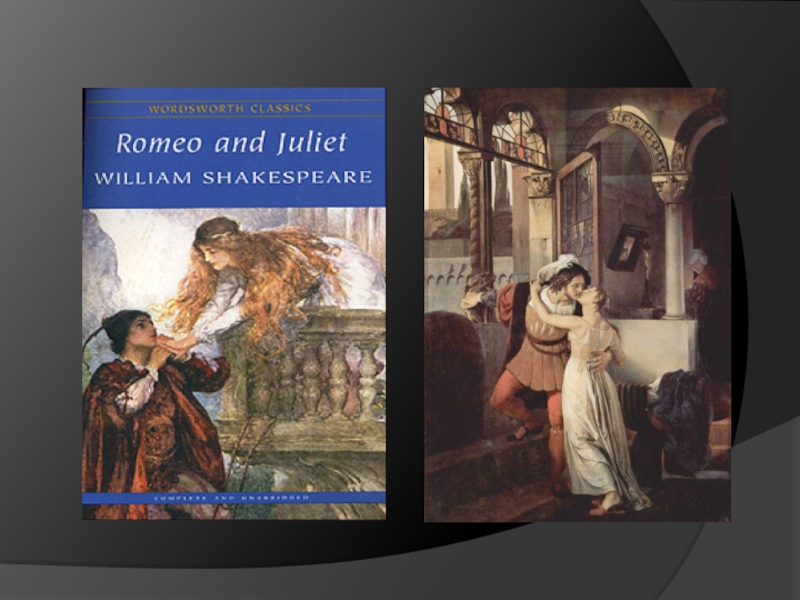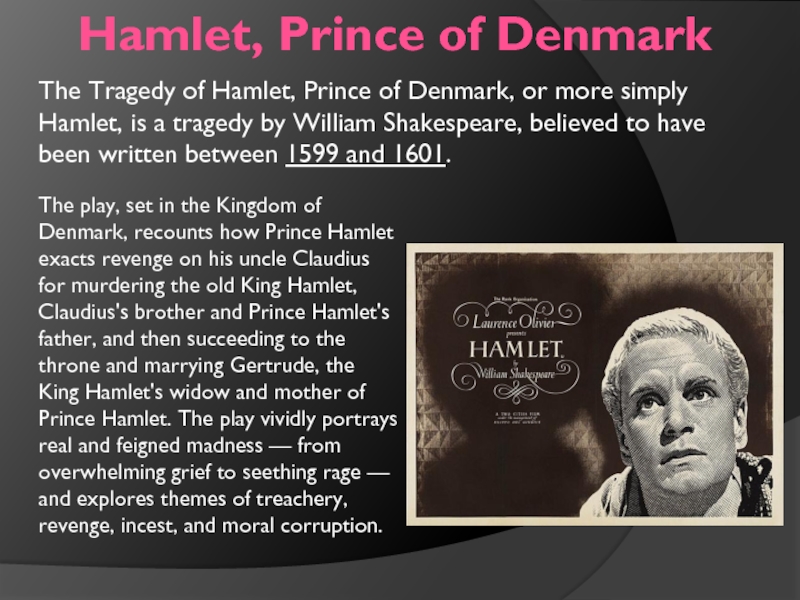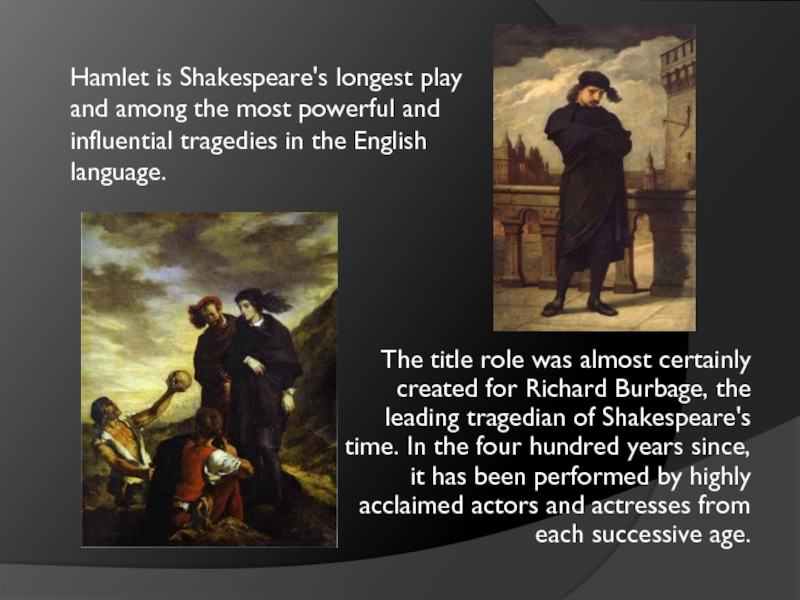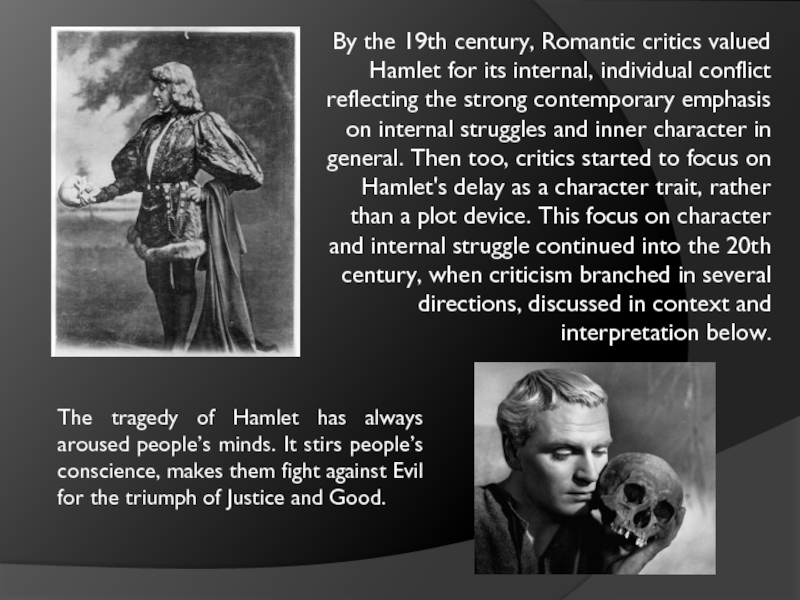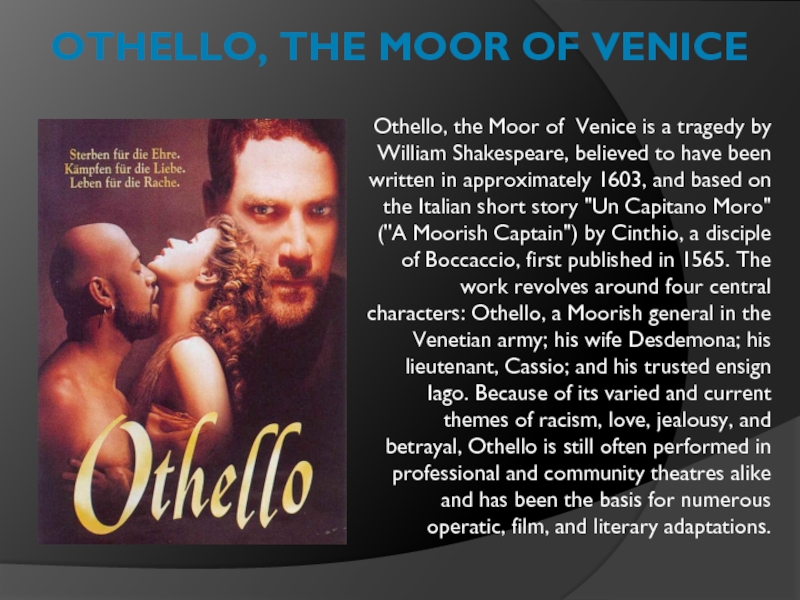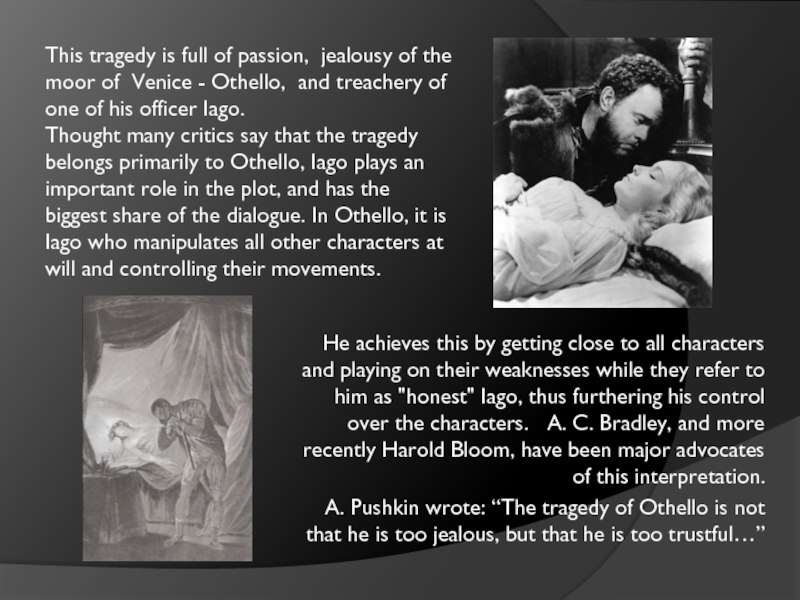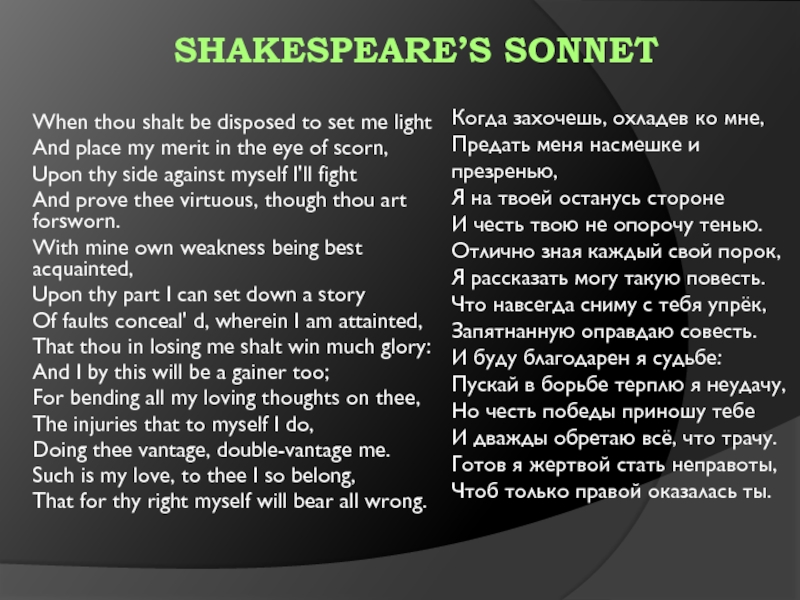- Главная
- Разное
- Образование
- Спорт
- Естествознание
- Природоведение
- Религиоведение
- Французский язык
- Черчение
- Английский язык
- Астрономия
- Алгебра
- Биология
- География
- Геометрия
- Детские презентации
- Информатика
- История
- Литература
- Математика
- Музыка
- МХК
- Немецкий язык
- ОБЖ
- Обществознание
- Окружающий мир
- Педагогика
- Русский язык
- Технология
- Физика
- Философия
- Химия
- Шаблоны, фоны, картинки для презентаций
- Экология
- Экономика
Презентация, доклад на тему Жизнь и творчество Уильяма Шекспира
Содержание
- 1. Жизнь и творчество Уильяма Шекспира
- 2. William Shakespeare (1564-1616) was an English
- 3. At the age of 18, Shakespeare married
- 4. It is not known exactly when Shakespeare
- 5. Later years and deathIn March 1613, he
- 6. Shakespeare was buried in the chancel of
- 7. Among his greatest masterpieces are such works
- 8. Its plot is based on an Italian
- 9. Romeo and Juliet is sometimes considered to
- 10. Shakespeare breaks from the normal sequence of
- 11. Слайд 11
- 12. The Tragedy of Hamlet, Prince of Denmark,
- 13. The title role was almost certainly created
- 14. By the 19th century, Romantic critics valued
- 15. Othello, the Moor of Venice is a
- 16. He achieves this by getting close to
- 17. Shakespeare’s sonnetWhen thou shalt be disposed to
- 18. Shakespeare’s greatness lies in the depth of
- 19. Thanks for your attention!!!
Слайд 2 William Shakespeare (1564-1616) was an English poet and playwright, now
Слайд 3
At the age of 18, Shakespeare married the 26-year-old Anne Hathaway,
William Shakespeare was the son of John Shakespeare, a successful glover and alderman originally from Snitterfield, and Mary Arden, the daughter of an affluent landowning farmer. He was born in Stratford-upon-Avon and baptised on 26 April 1564.
His unknown birthday is traditionally observed on 23 April, St George's Day. Shakespeare was educated at the King's New School in Stratford, a free school chartered in 1553, about a quarter of a mile from his home.
Early Life
Слайд 4It is not known exactly when Shakespeare began writing, but contemporary
Greene’s attack is the first recorded mention of Shakespeare’s career in the theatre. Biographers suggest that his career may have begun any time from the mid-1580s to just before Greene’s remarks. From 1594, Shakespeare's plays were performed only by the Lord Chamberlain's Men, a company owned by a group of players, including Shakespeare, that soon became the leading playing company in London. After the death of Queen Elizabeth in 1603, the company was awarded a royal patent by the new king, James I, and changed its name to the King's Men. Some of Shakespeare's plays were published in quarto editions from 1594. By 1598, his name had become a selling point and began to appear on the title pages. Shakespeare continued to act in his own and other plays after his success as a playwright.
Shakespeare divided his time between London and Stratford during his career.
London and theatrical career
Слайд 5Later years and death
In March 1613, he bought a gatehouse in
Shakespeare died on 23 April 1616, and was survived by his wife and two daughters. Susanna had married a physician, John Hall, in 1607, and Judith had married Thomas Quiney, a vintner, two months before Shakespeare’s death.
After 1606–7, Shakespeare wrote fewer plays, and none are attributed to him after 1613. His last three plays were collaborations, probably with John Fletcher, who succeeded him as the house playwright for the King’s Men.
Rowe was the first biographer to pass down the tradition that Shakespeare retired to Stratford some years before his death; but retirement from all work was uncommon at that time, and Shakespeare continued to visit London. In 1612, he was called as a witness in a court case concerning the marriage settlement of Mountjoy's daughter, Mary.
Слайд 6Shakespeare was buried in the chancel of the Holy Trinity Church
Слайд 7Among his greatest masterpieces are such works as tragedies “Romeo and
The comedies describe the adventures of young men and women, their friendship and love, their search for happiness.
The tragedies reflect the deep, insoluble contradictions of life, the falsehood, injustice and tyranny existing in society. They show people who perish in the struggle against Evil.
Shakespeare is the author of 2 poems, 37 plays and 154 sonnets. His creative work is usually divided into three periods.
THE WORKS OF W.SHAKESPEARE
Слайд 8
Its plot is based on an Italian tale, translated into verse
Romeo and Juliet
The tragedy "Romeo and Juliet" stands apart from the other tragedies. It was written during the first period of Shakespeare's creative work, when most of his comedies appeared. The play is full of love, youth and humanism.
Слайд 9Romeo and Juliet is sometimes considered to have no unifying theme,
"O brawling love, O loving hate,
O any thing of nothing first create!
O heavy lightness, serious vanity,
Misshapen chaos of well-seeming forms,
Feather of lead, bright smoke, cold fire, sick health,
Still-waking sleep, that is not what it is!"
— Romeo, Act I Scene
Слайд 10Shakespeare breaks from the normal sequence of courtship. Usually a woman
In the final suicide scene, there is a contradiction in the message — in the Catholic religion, suicides were often thought to be condemned to hell, whereas people who die to be with their loves under the "Religion of Love" are joined with their loves in paradise. Romeo and Juliet's love seems to be expressing the "Religion of Love" view rather than the Catholic view. Another point is that although their love is passionate, it is only consummated in marriage, which prevents them from losing the audience's sympathy.
Слайд 12The Tragedy of Hamlet, Prince of Denmark, or more simply Hamlet,
Hamlet, Prince of Denmark
The play, set in the Kingdom of Denmark, recounts how Prince Hamlet exacts revenge on his uncle Claudius for murdering the old King Hamlet, Claudius's brother and Prince Hamlet's father, and then succeeding to the throne and marrying Gertrude, the King Hamlet's widow and mother of Prince Hamlet. The play vividly portrays real and feigned madness — from overwhelming grief to seething rage — and explores themes of treachery, revenge, incest, and moral corruption.
Слайд 13
The title role was almost certainly created for Richard Burbage, the
Hamlet is Shakespeare's longest play and among the most powerful and influential tragedies in the English language.
Слайд 14By the 19th century, Romantic critics valued Hamlet for its internal,
The tragedy of Hamlet has always aroused people’s minds. It stirs people’s conscience, makes them fight against Evil for the triumph of Justice and Good.
Слайд 15Othello, the Moor of Venice is a tragedy by William Shakespeare,
Othello, The moor of Venice
Слайд 16He achieves this by getting close to all characters and playing
A. Pushkin wrote: “The tragedy of Othello is not that he is too jealous, but that he is too trustful…”
This tragedy is full of passion, jealousy of the moor of Venice - Othello, and treachery of one of his officer Iago.
Thought many critics say that the tragedy belongs primarily to Othello, Iago plays an important role in the plot, and has the biggest share of the dialogue. In Othello, it is Iago who manipulates all other characters at will and controlling their movements.
Слайд 17Shakespeare’s sonnet
When thou shalt be disposed to set me light
And
Upon thy side against myself I'll fight
And prove thee virtuous, though thou art forsworn.
With mine own weakness being best acquainted,
Upon thy part I can set down a story
Of faults conceal' d, wherein I am attainted,
That thou in losing me shalt win much glory:
And I by this will be a gainer too;
For bending all my loving thoughts on thee,
The injuries that to myself I do,
Doing thee vantage, double-vantage me.
Such is my love, to thee I so belong,
That for thy right myself will bear all wrong.
Когда захочешь, охладев ко мне,
Предать меня насмешке и презренью,
Я на твоей останусь стороне
И честь твою не опорочу тенью.
Отлично зная каждый свой порок,
Я рассказать могу такую повесть.
Что навсегда сниму с тебя упрёк,
Запятнанную оправдаю совесть.
И буду благодарен я судьбе:
Пускай в борьбе терплю я неудачу,
Но честь победы приношу тебе
И дважды обретаю всё, что трачу.
Готов я жертвой стать неправоты,
Чтоб только правой оказалась ты.


